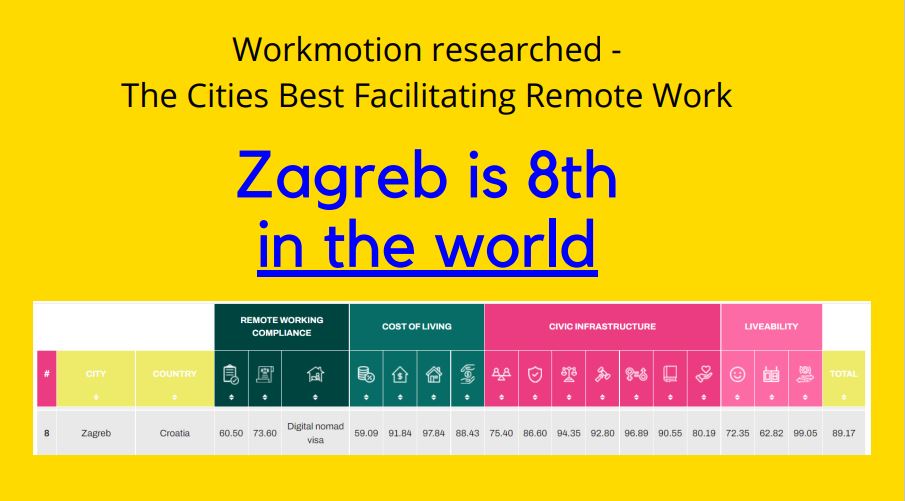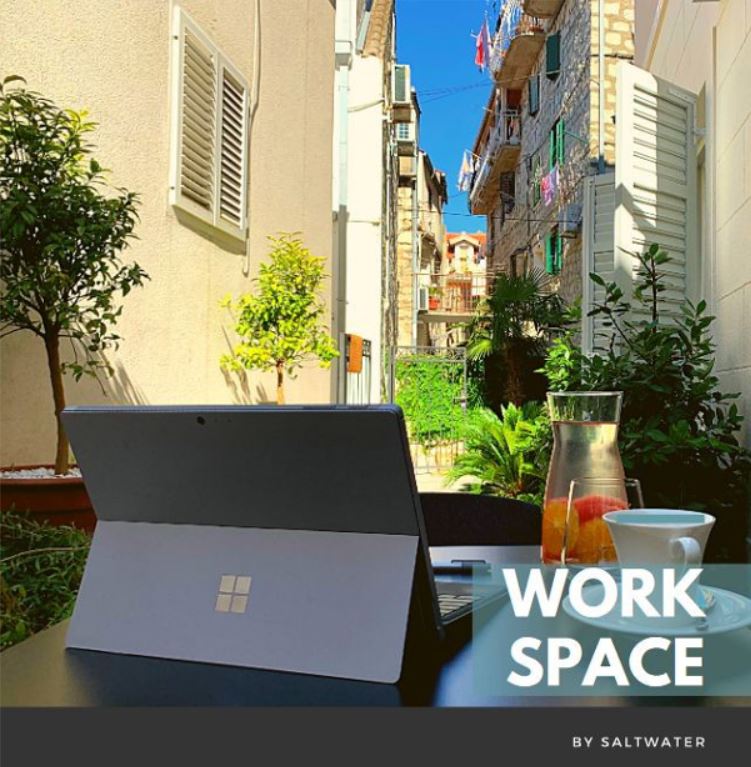People also ask Google: Is Dubrovnik or Split Better?
March 4, 2021 - In our latest People also ask Google series, we attempt to tackle the impossible - is Dubrovnik or Split better?
Ah, the tale of two ancient cities, both breathtaking in their own ways. One, the Adriatic Pearl, the other, Dalmatia's bustling capital - but both full of pride that there is no better place.
Their vibrant history more or less defines them. Dubrovnik's roots trace back to the 7th century when it was founded as Ragusa by inhabitants of the ancient Greek colony of Epidaurus (present-day Cavtat). Split, on the other hand, founded as the Greek colony Aspálathos only a bit earlier, in the 3rd or 2nd century BC.
Centuries later, both cities are certainly known for their turbulent history and historic cores - Dubrovnik, a town wrapped by medieval defensive walls, and Split, a city that boasts the 1700-year-old Diocletian's Palace, the former retirement home of Roman Emporer Diocletian.
While it may be humanely IMpossible to decide which is better, we do know one thing: these ancient artifacts have turned two coastal cities into tourism champions in much more recent years, where history mixes with the mood of the Meditteranean to make for one stellar holiday.
Is it better to stay in Dubrovnik or Split?
We recently covered how many days you should spend in Dubrovnik, much like the magic number for Split, but where should you stay in both cities?
Dubrovnik abounds in 5-star hotels and villas, attracting luxury travelers thanks to its deluxe amenities. From the Excelsior, Rixos, and Sun Gardens to the centrally-located Hilton Imperial and lavish Grand Villa Argentina, tourists with higher spending power really have their pick when it comes to the upper echelon of hotels in the area. And that's without mentioning ultra-luxurious villas, like Sheherezade.
Private accommodation in Dubrovnik, however, can get a bit tricky. While basic old-town offers in the summer can cost you an arm and a leg, literally and figurately (remember, endless flights of stairs and NO elevators), apartments outside of the center, while more affordable, are less accessible. Yes, taxis and Uber do exist, but so do narrow roads and summer traffic, both of which plague Dubrovnik in the peak season.
Split, on the other hand, is still a bit behind in the luxury hotel world. And to compensate for its lack of hotel rooms, the city has seen a boom in private accommodations over the last few years, with things getting a little out of hand.
But there is hope.
The newly-opened 4-star Amphora Hotel has done a significant job adding to the hotel capacity in Split with 206 rooms, while newcomers like briig boutique hotel add flair to the Bačvice neighborhood. The Birkenstock-owned Ambasador will add 101 rooms to the West Coast sometime this year, while the Adris Group will step into the Dalmatian market with the hopeful opening of the 'new' hotel Marjan in 2022.
Lovers of luxury hotels can currently only choose from the 5-star Le Meridien Lav hotel, located about 15 minutes outside of Split in Podstrana, or the beloved Bačvice-based Hotel Park. However, the history-rich-heritage hotels in the center make up for any missing affluence (check out Palace Judita, Heritage Hotel Antique, or Jupiter, for example).
Does Split or Dubrovnik have better beaches?
Bačivce or Banje? It's unlikely you'll spend an hour in either city without hearing their names.
Bačivce, Split's public beach, is located about a 10-minute walk outside of Diocletian's Palace. A sandy beach popular for speedo-clad picigin players, Bačivce boasts views that extend out to Brač during the day, while it is the hub of Split nightlife in the evening, where young partygoers let loose until sunrise. Needless to say, things can get a bit messy (and crowded).
On the other hand, Dubrovnik's public Banje beach is a short walk from the old town, with views onto the city walls and harbor. While you'll be hard-pressed to find a more unique swimming spot, it is penetrated by thirsty tourists in the summertime, making it often impossible to claim a lounge chair.
Fortunately, Bačice and Banje aren't the only beaches in Split in Dubrovnik. Split's coast is decorated with beaches, as is Marjan Hill, where you'll find Kaštelet, situated just below the Ivan Meštrović Gallery, or Kašjuni, boasting a deep bay with the cliffs wrapping around you.
Šulići is just a short walk from the Pile Gate in Dubrovnik, while the family-friendly Copacabana beach in Babin Kuk offers a restaurant, water sports, and cocktails for the adults. And if you have a car? Head 30 minutes south of Dubrovnik to discover the best beaches in Konavle!
Is Dubrovnik or Split nightlife better?
As someone who just crossed over into her 30s after a vibrant decade of partying in her 20s, the answer to this one comes quite easily. One thing young travelers visiting Dubrovnik often mention is the lack of nightlife in the city. And as it should be, because Dubrovnik's beauty shouldn't be embraced with a hangover. However, you can't deny that people want to let loose on holiday, whether they're at a pub or a club. So, where to?
For those who enjoy partying until the early morning hours, there is one special place to go - Culture Club Revelin. It even made DJ Mag's Top 50 Best Clubs in the World. Located in a 500-year-old medieval fortress, it'll be hard to find another setting as unique. Just like it'll be hard to find another club Dubrovnik.
And if you're not the clubbing type after all? Dubrovnik flourishes with cafe and wine bars, and there are even a few Irish pubs!
Split, on the other hand, has become a hotspot for Croatian nightlife. After the wine-bar-boom came the craft-cocktail-bar boom, and there is a nightclub for all types of partygoers. Bar crawls also rule summer nightlife, and all roads eventually lead to the Bačvice beach clubs, where you can enjoy a sunrise swim if you stay long enough.
Split's live music scene also thrives most of the year; you can catch up-and-coming Croatian acts or touring international DJs if you're lucky!
Are Split or Dubrovnik restaurants better?
Both Split and Dubrovnik have upped their culinary game in the last few years. Dubrovnik currently boasts 10 Michelin-recommended restaurants, while one restaurant, 360, carries a Michelin star. And because it is a luxury destination, you'll notice more fine dining options in Dubrovnik than Split.
Split cannot currently boast a Michelin star, though it does have five Michelin-recommended restaurants and many trendy newcomers that add flair to classic Dalmatian cuisine.
Long gone are the days of only ćevapi and pomfret (though you'll still find it on most konoba menus), as both cities have become creative in their culinary offers, with many international options on the table too. If you're after the flavors of sushi, Mexican, Thai, or Chinese, or want to keep it traditional with grilled fish, black risotto, and octopus salad, you'll be pleased eating in either city.
Would you choose Dubrovnik or Split in October?
Ah, the offseason debate is back again!
If you'd like my personal opinion, both cities are a gem in October, that is, if you're not coming to Croatia solely for the sun, sea, and swimming. October weather could also surprise, and you may find that Indian Summer comes out to play.
Best-case scenario - you're swimming in slightly cooler sea temperatures with fewer boats and emptier beaches. Worst-case scenario, you're stuck in the rain and have to schedule your outdoor activities around when it's dry - so you get to sit in a cafe and people watch or enjoy museums to kill time instead. Is that really so bad?
Realistically, most everything remains open in both cities throughout October, making it easier for you to enjoy what you'd plan on doing in summer without fighting sweaty bodies wanting to do the same thing.
October is also a good time to enjoy emptier roads, so why not take a road trip from Dubrovnik to Pelješac for wine tasting? Or from Split to Omiš for ziplining over the canyon? The opportunities are endless.
In conclusion: Is Dubrovnik or Split better?
The real question is - which city is better for you?
One might suggest that if you're young, looking for vibrant nightlife, good food options, and easy access to the islands, you'll fit better in Split. And if you're a Game of Thrones fan looking to tick tourist attractions off your list? You'll likely choose Dubrovnik. But both cities offer something for all ages and all members of the family, and because they're only 3 hours apart by car, you don't really have to choose at all.
To follow the People Also Ask Google about Croatia series, click here.
PHOTOS: Cafe Terraces Reopen in Split After Three Months
March 1, 2021 - Cafe terraces reopen in Split after three (very long) months! A look at the cafe scene in sunny Split today.
March is off to a fabulous start as cafe terraces around Croatia reopen for the first time in three months.
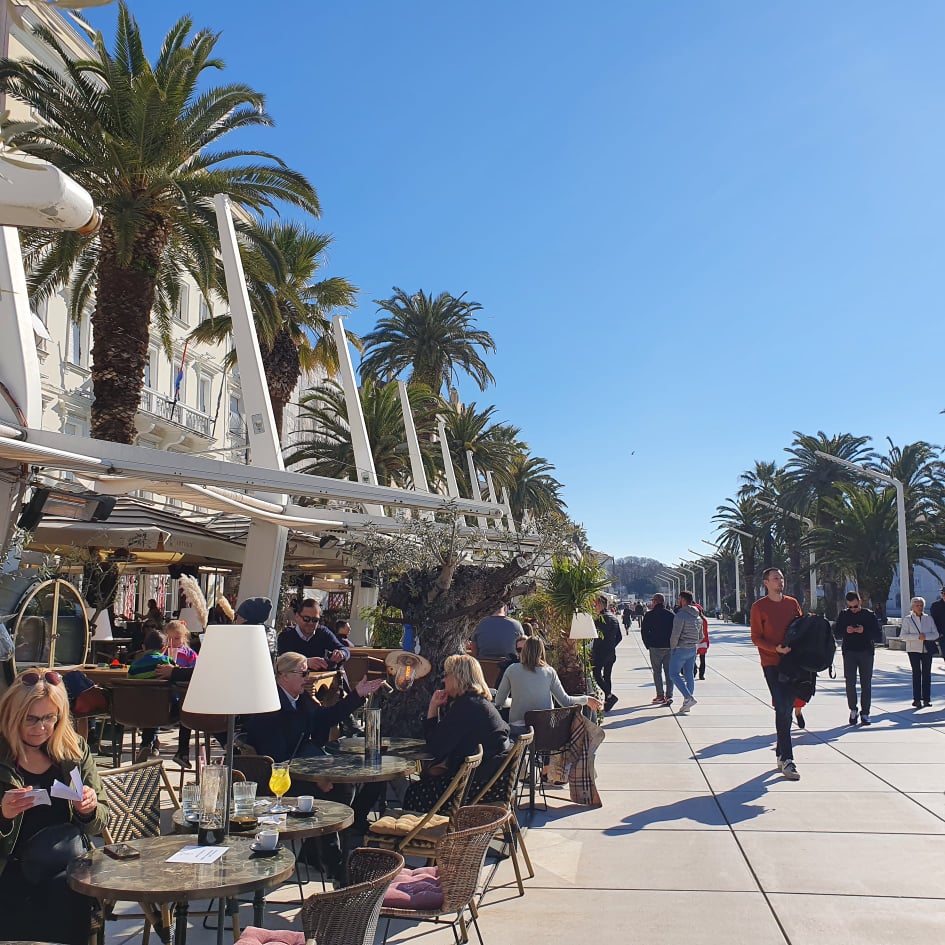
Recall, the National Civil Protection Headquarters announced last week that cafe terraces would reopen, but still under some strict guidelines. Namely, catering facilities can operate from 6 am to 10 pm, but only in open areas of the facility, while respecting the distance between guests of a minimum of three meters between tables and 1.5 meters between chairs. Terraces with plexiglass must be opened to allow airflow.
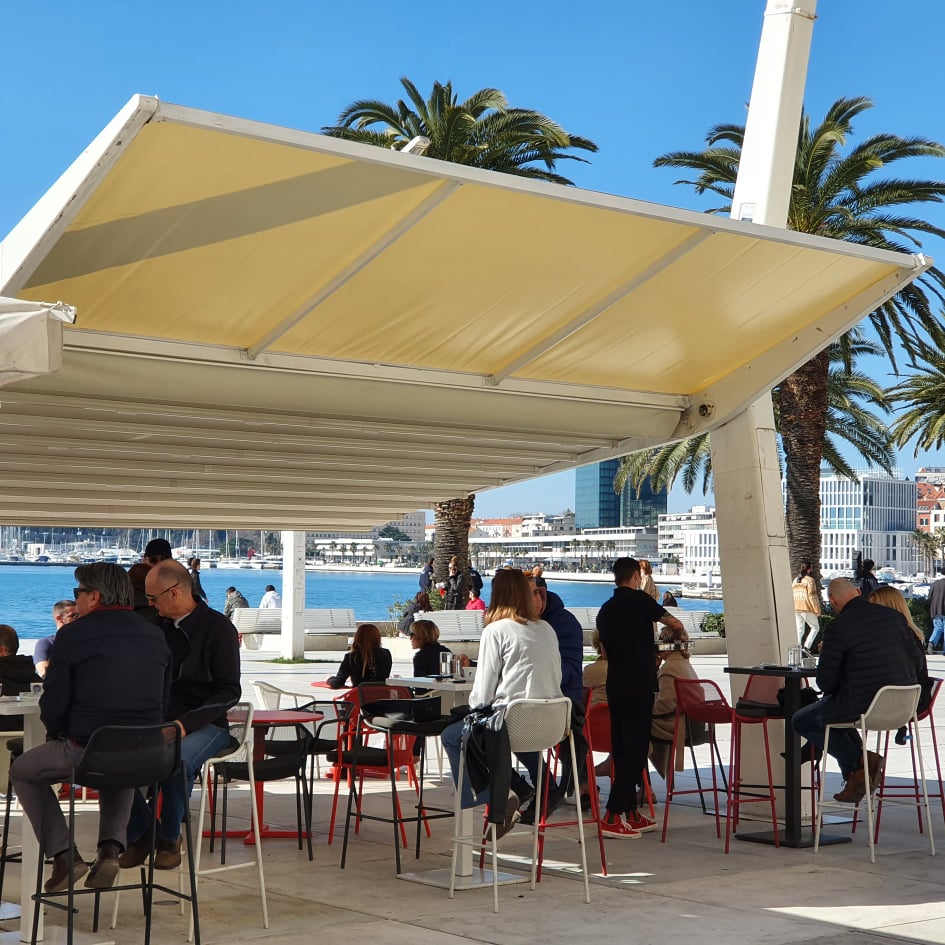
Hand disinfectant should also be available at the entrance, and masks are required when going to the toilet indoors, which must be clearly stated.
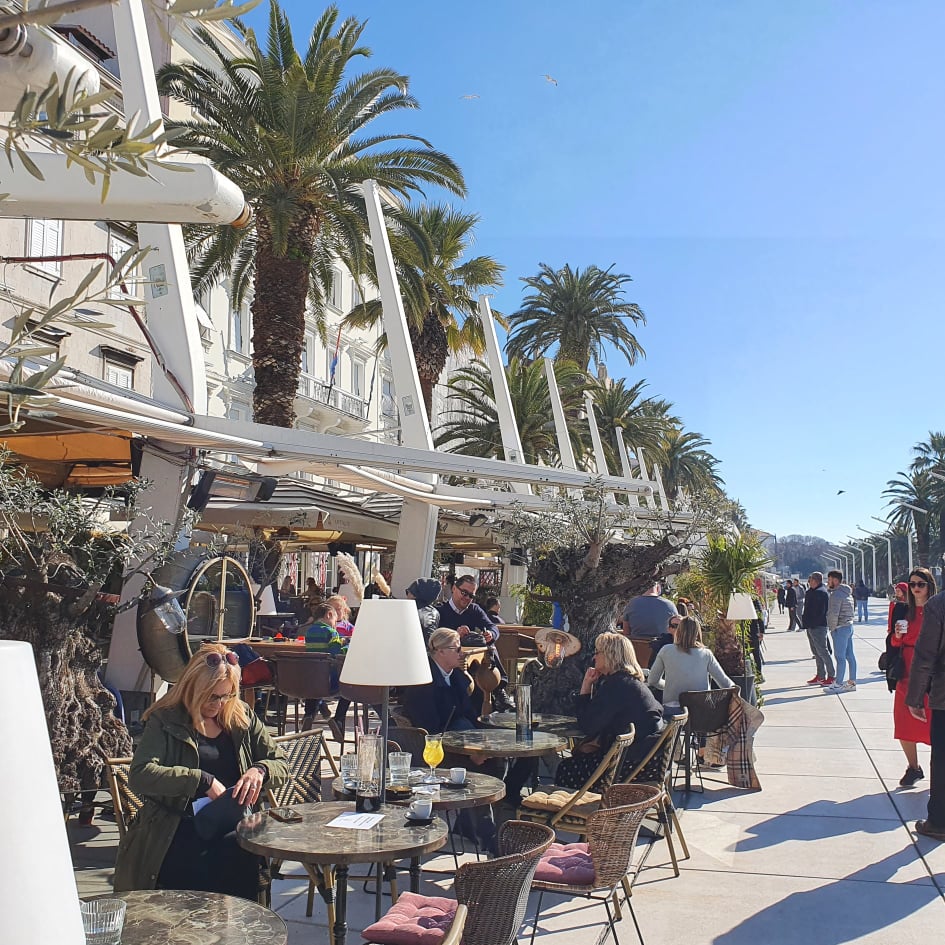
Music was originally banned, but the associations of musicians and caterers reached an agreement with the Headquarters, so music is also allowed, provided it is not too loud.
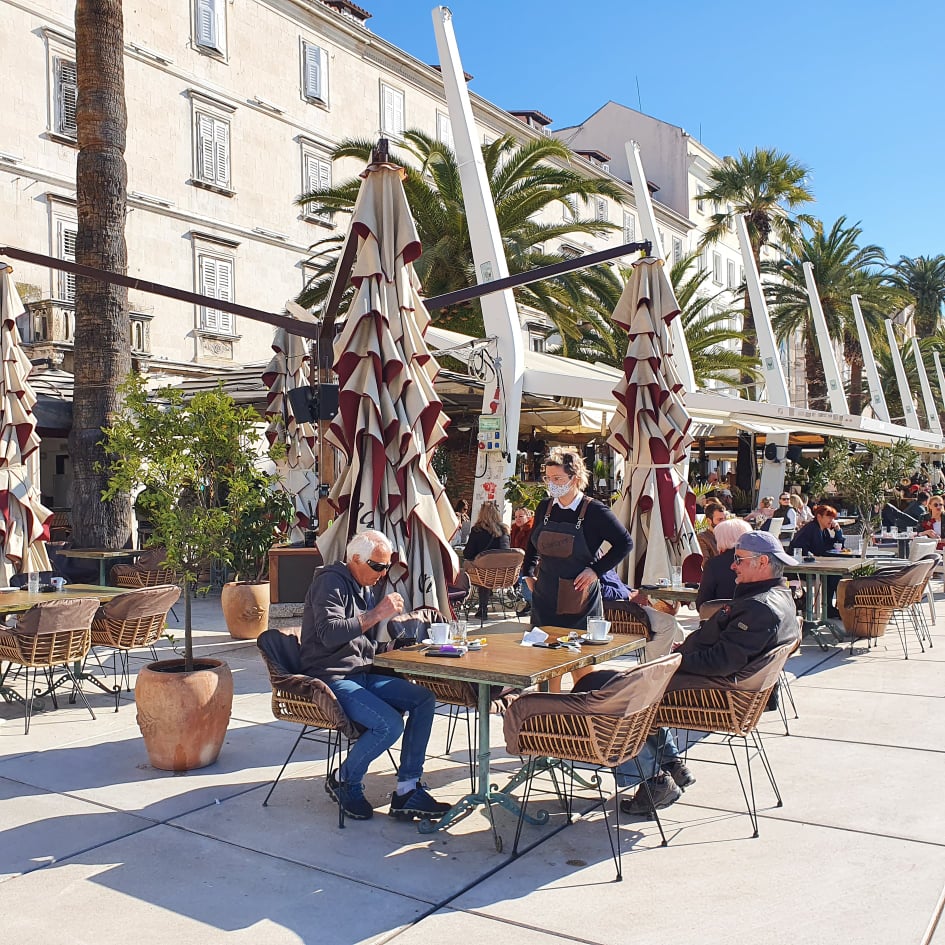
On a sunny morning in Split, with temperatures already reaching 14 degrees Celsius by 10 am, eager citizens flocked to cafe terraces around the city, and especially to the beloved Riva, where they had to fight for benches or enjoy hot drinks propped up against walls until now.
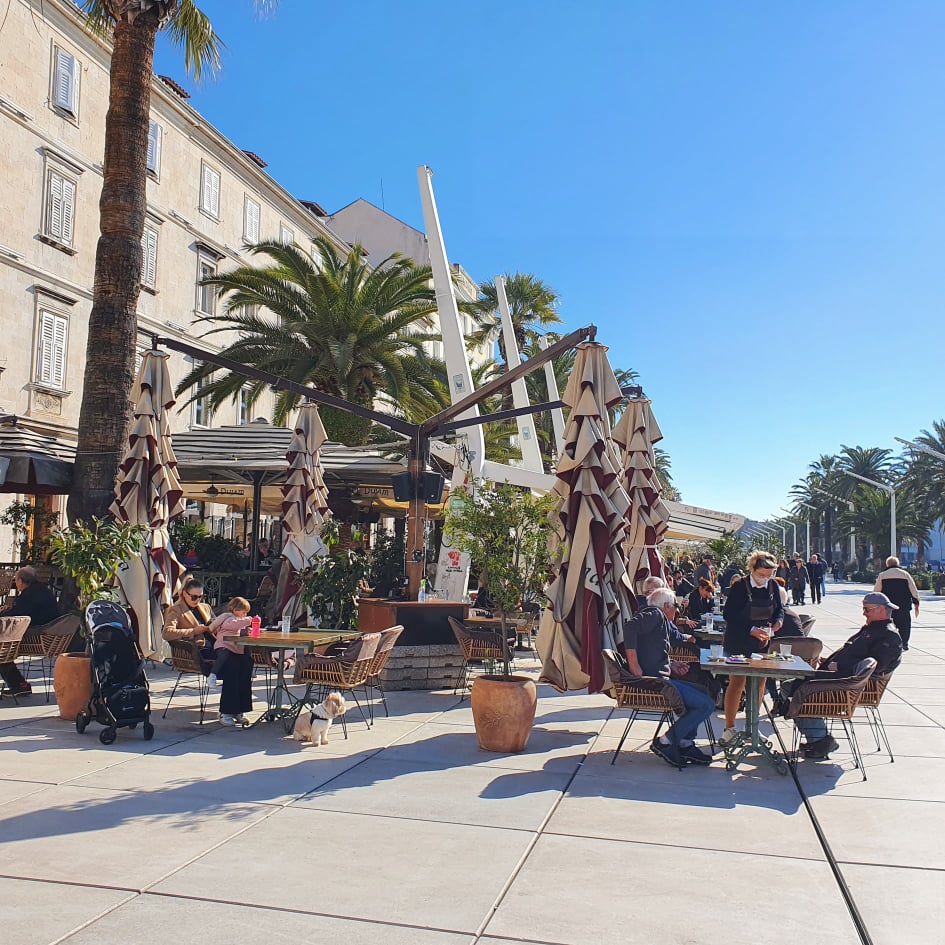
Waiters expect the biggest buzz around noon, though many early birds could hardly wait to reinstate their morning ritual - coffee, newspaper, and good company.
In the past 24 hours, 91 new coronavirus infections and 11 related deaths have been registered in Croatia, the national COVID-19 response team said on Monday.
There are currently 2,892 active cases, including 791 hospitalized patients, 64 of whom are on ventilators.
Since 25 February 2020, when the first case was registered in Croatia, 243,064 cases have been registered, including 5,537 deaths.
A total of 234,635 patients have recovered, including 401 in the past 24 hours.
Currently, 14,074 people are self-isolating.
To date, 1,346,946 people have been tested for the virus, including 2,294 in the past 24 hours.
Photos by Mirela Rus
To read more about lifestyle in Croatia, follow TCN's dedicated page.
Swiss Readies for Summer with New Flights from Geneva to Split!
March 1, 2021- The Swiss national airline is readying for summer with the announcement of flights from Geneva to Split, scheduled to operate during the peak season, from the beginning of July to the end of August.
Croatian Aviation reports that Swiss national airline will introduce a new route to Croatia in this year's summer flight schedule, with flights from Geneva to Split!
The Swiss national airline has announced its summer flight schedule for this year and announced the introduction of a number of new routes from Geneva. In a series of new lines, there is one to Croatia, to Split Airport.
Namely, from July 3, Swiss will introduce the Geneva-Split-Geneva line, which will operate twice a week. A220-300 aircraft with a capacity of 145 seats will operate on the route, and tickets are not on sale yet. The company announced that booking on the new lines from Geneva will be possible at the beginning of this month, i.e., in the next few days.
There is already a direct airline between Geneva and Split, as easyJet operated on this route in the previous seasons. The well-known low-cost carrier has announced flights between the two mentioned cities this summer season as well, as early as April.
Swiss used to travel to Zagreb from Zurich, but that line was canceled even before the pandemic, and also from Geneva to Pula and Dubrovnik. The Pula-Geneva line will not operate in the summer of 2021, while the line to Dubrovnik has been announced from Saturday, July 3, only once a week.
The new Swiss line from Geneva to Split, as well as the line to Dubrovnik, will operate briefly, until the last Saturday in August, i.e., only in the peak of the summer season. EasyJet, on the other hand, plans to operate on lines from Switzerland to Croatia until the end of October.
For the latest travel info, bookmark our main travel info article, which is updated daily.
Read the Croatian Travel Update in your language - now available in 24 languages.
Iconic Split Riva Venue Brasserie on 7 Reopens with Exciting News!
February 27, 2021 - The iconic Split Riva venue Brasserie on 7 reopens with a new French/American Chef de Cuisine!
One of Split’s most attractive dining venues, Brasserie on 7 is reopening Monday, March 1st, for the 2021 season, with an exciting new chapter, by appointing French / American Alexandre Ange as Chef de Cuisine.
“After such a tough 2020 for the tourism and hospitality industry, I am thrilled to welcome Alex as our new Executive Chef. Sparked with passion for Mediterranean cuisine, we are absolutely delighted that Alex is joining our team, thus helping to further develop our culinary story! “ – says with excitement Maria Mustapic, one of the two owners of Brasserie on 7.
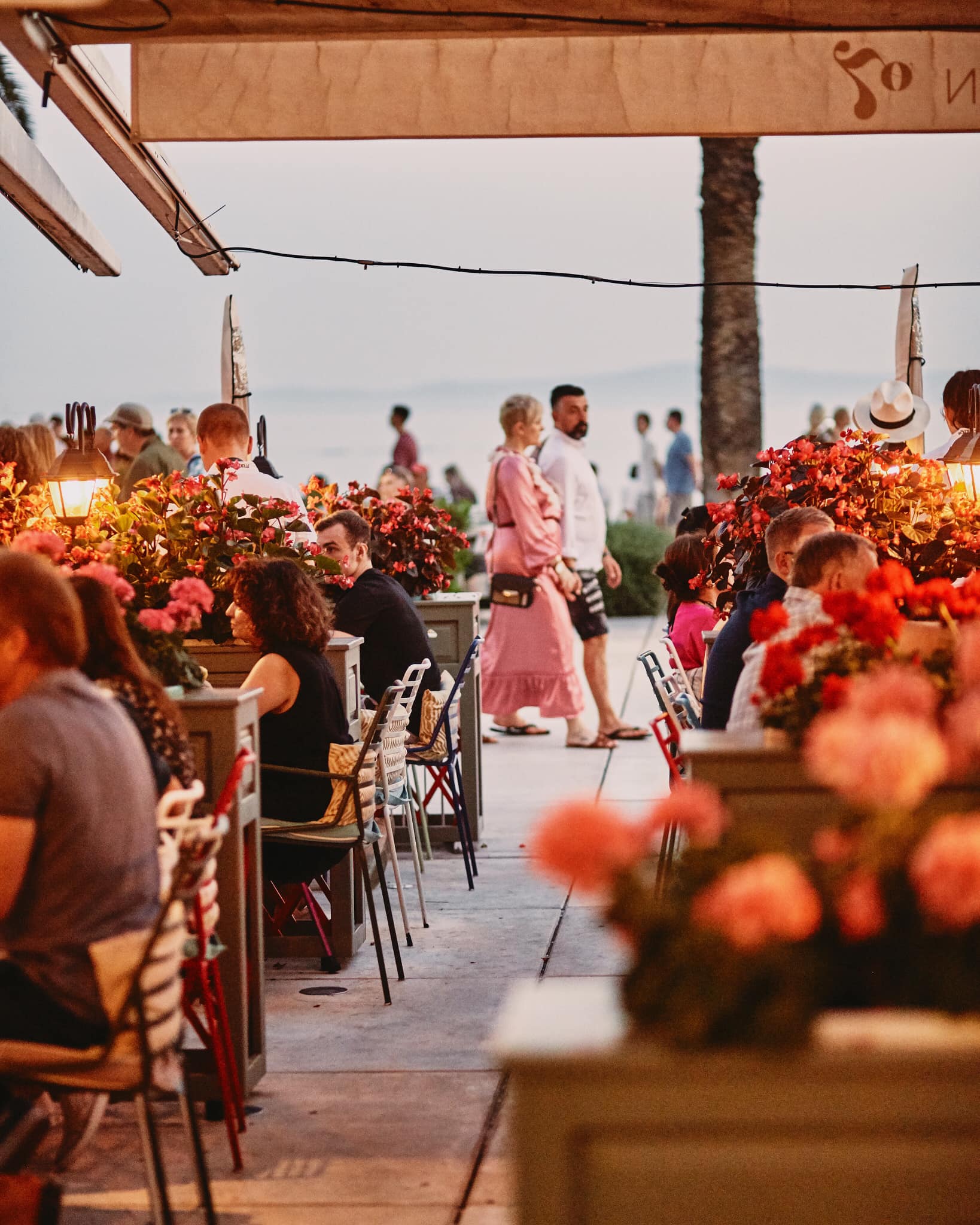
Classically trained in French cuisine, Alex has spent the past 12 years working in some of the top restaurants in France & the United States, including the famous L’Atelier in Paris, run by Chef Joel Robuchon (the chef with the most Michelin stars in the world). Alex made the move to Split, together with his family, with an exciting vision on how to expand and improve on the imaginative and inventive À la carte menu that B7 is already famous for:
“I strongly believe in using local ingredients and supporting Dalmatian producers. My vision is to bring our guests an exceptional and memorable dining experience by introducing a renovative food menu that satisfies the taste bud of local and international guests”, pledges Ange.
This spring, the new B7 Executive Chef will be introducing subtle changes across the menu, while using the very best produce Croatia has to offer.
“Delicious exciting changes are coming to our breakfast, lunch and dinner menus - including vegetarian and vegan dishes, but we will let you discover them when you visit us at Brasserie on 7 in Split this season, we are very eager to reopen on March 1st” invitingly says front of house Ivan Rabadan.
For the last seven years, Brasserie on 7 has become known for its world class breakfast in an iconic Riva setting, a casual upscale café vibe for lunch and a refined coastal French inspired Adriatic dinner to both tourists and locals alike.
„Our goal, as always, is to provide a memorable dining experience for each and every one of our guests. And with the addition of Alex I am confident that Brasserie will reach new heights“, says Korana Bucic, the other half of the power duo behind B7' success.
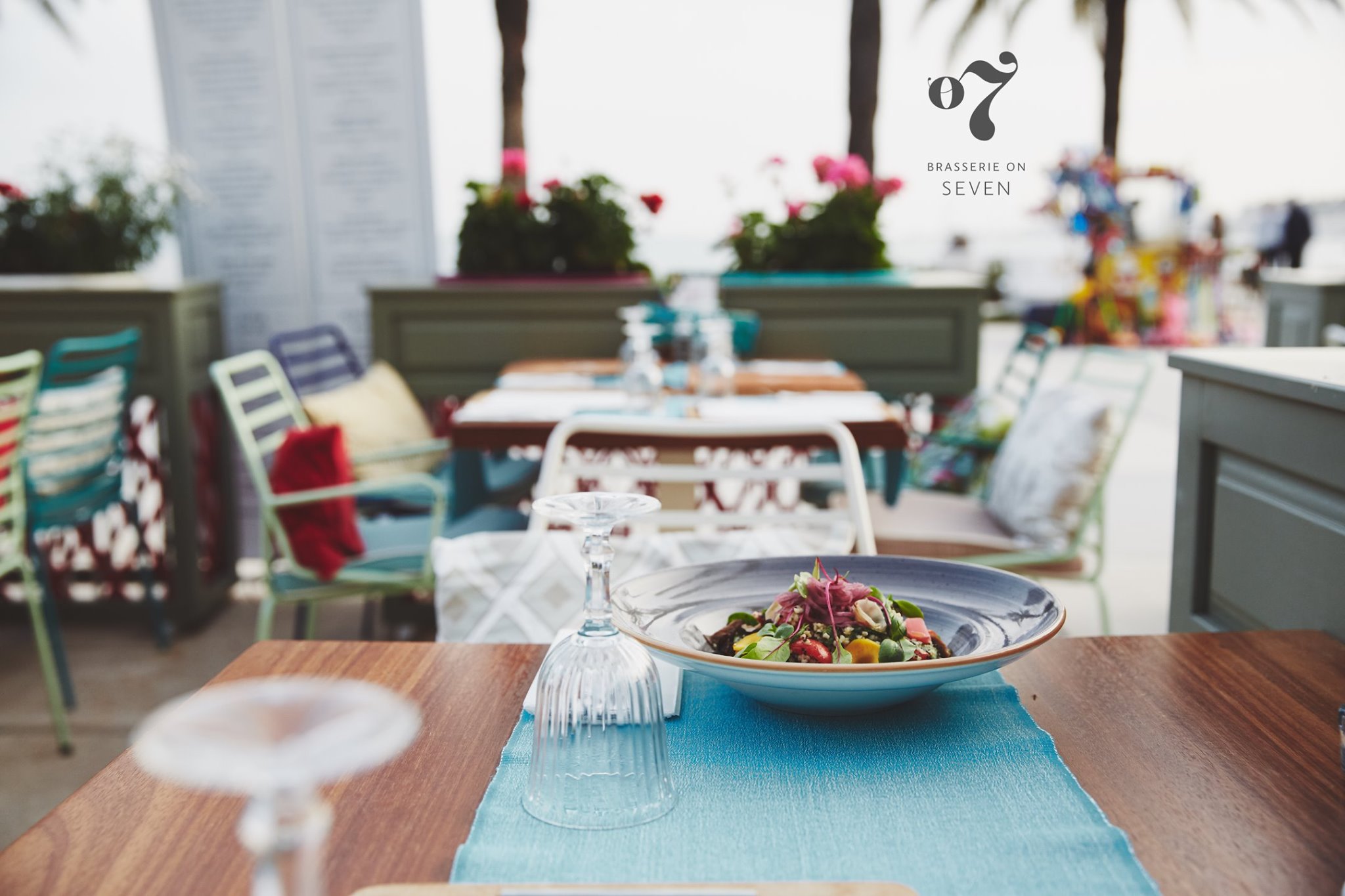
Born and raised in Australia, childhood friends Maria Mustapic and Korana Bucic returned to Croatia in 2006 and made waves when they opened the first registered hostel in Split. Then they just kept going, opening a second hostel, Charlie's backpackers bar, Zinfandel food & wine bar and – in March 2014 – adding Brasserie on 7 as the crown-jewel of their business portfolio.
ABOUT CHEF ALEXANDRE ANGE
Classically trained in French cuisine, Alex Ange has spent the past 12 years working in some of the top restaurants in France and the United States.
His career started in New York City, working as a stagiaire in various restaurants as a summer job during high school. After graduating, he decided to pursue cooking as a profession, and returned to France to begin a professional culinary apprenticeship under chef Joel Robuchon (the chef with the most Michelin stars in the world) at his restaurant L’Atelier in Paris.
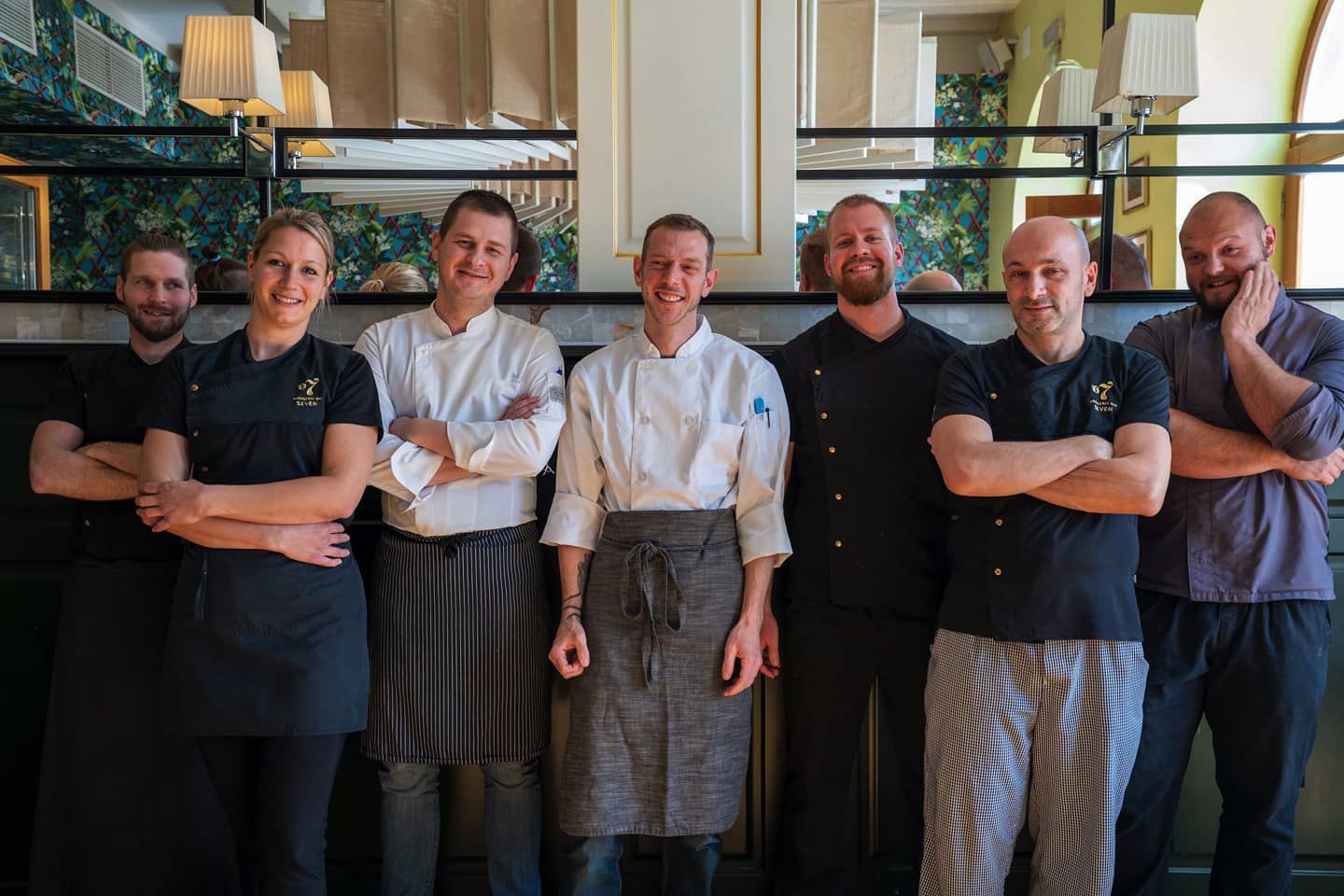
This opened many doors and enabled him the opportunity to work with some of world’s best chefs, including Thomas Keller and Philippe Tessier at The French Laundry in California’s Napa Valley, Joshua Skenes at Saison in San Francisco, Daniel Boulud at Restaurant Daniel in New York, as well as Marcus Samuelsson.
ABOUT BRASSERIE ON 7
Owned by business power-duo Korana Bucic & Maria Mustapic, Brasserie on 7 is located on the most sought-after location in Split, on the stunning Riva, overlooking the Adriatic Sea.
Since it opened, in March 2014, B7 has been run under the competency of Ivan Rabadan as front of house.
The operation is reinforced by quality with multi award winning barista Matea Vuletic, and an inhouse pastry and bakery team run by the talented Ivana Bradaric since 2015. Known for its sweet Tuesdays on the Riva.
B7 staff has been constantly improving on their skills, by enrolling in work experiences in Zagreb, Marseille, London, as well as many culinary and Food&Beverages workshops and courses. The team won Gourmet Expo in 2019.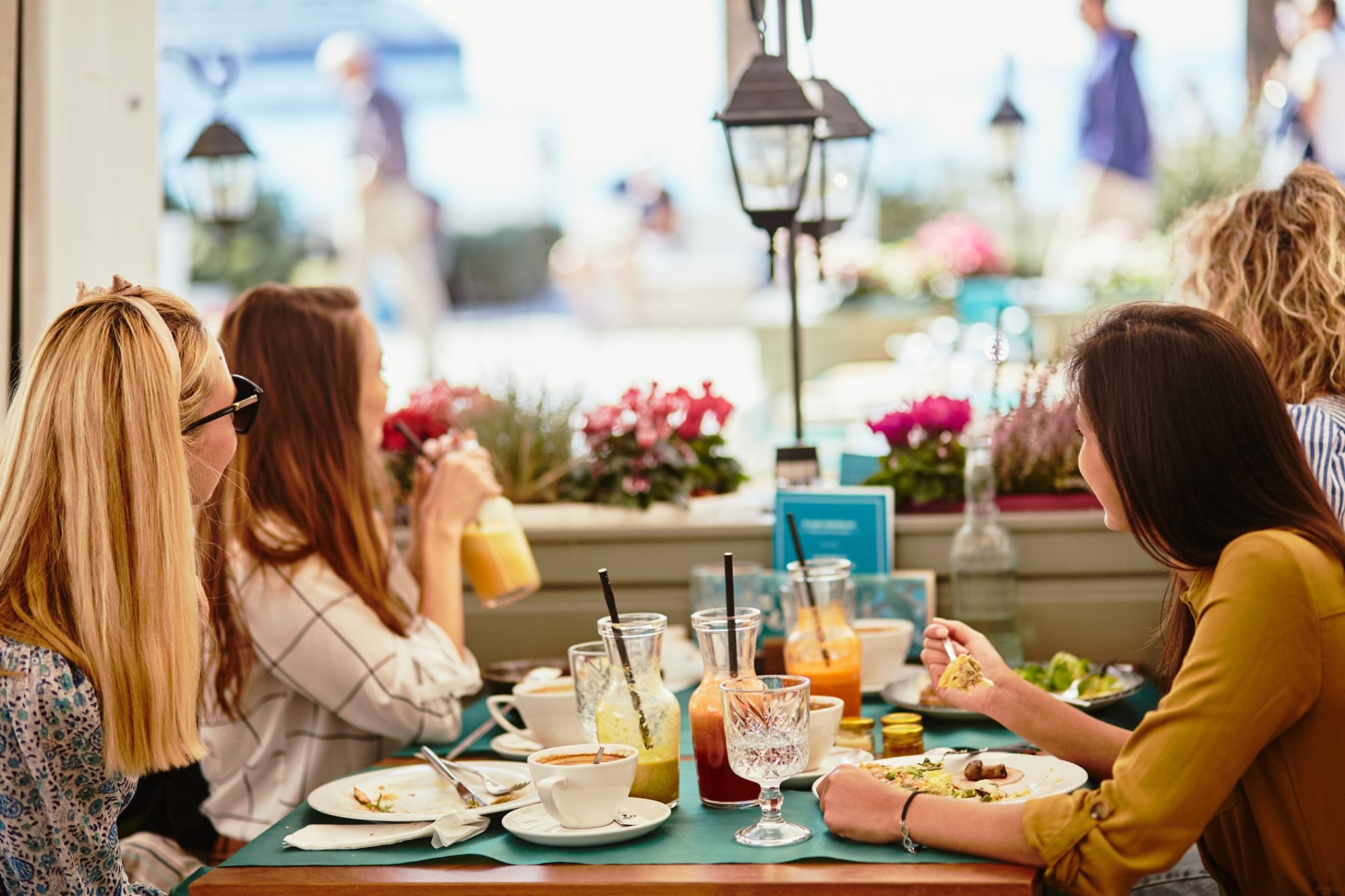
Brasserie on 7 takes pride in being part of the community and contributing whenever they can, including the humanitarian fundraising of up to 90,000kn for the children’s ward in Split. In the recent crisis of COVID, both B7 and Zinfandel restaurants took part in cooking for the medical staff and most recently their chefs showed homage to the citizens of Petrinje, affected by the recent devastating earthquakes, by joining the 300 volunteer chefs that cooked for them.
To read more about lifestyle in Croatia, follow TCN's dedicated page.
Smartwings Flights from Prague to Split, Dubrovnik Coming this Summer!
February 26, 2021 - Smartwings flights from Prague to Split and Dubrovnik will operate this summer!
Croatian Aviation reports that the Czech low-cost airline Smartwings has announced two routes to Croatia in the upcoming summer flight schedule.
Namely, Smartwings plans to connect Prague with Split and Dubrovnik this summer. In 2020, the company operated between Prague and Split, while the line to Dubrovnik was suspended for obvious reasons.
In the 2021 summer flight schedule, the company plans to resume traffic to both mentioned destinations later than in 2019.
The Prague-Split-Prague line will operate from May 1, once a week, every Saturday. From June 1 to October 10, daily flights on this line have been announced.
Smartwings will operate B737-800, B737-900ER aircraft to Split, and B737-MAX-8 aircraft have also been announced, or aircraft that received a permit for re-operation less than a month ago. Just yesterday, February 25, the company made its first commercial flight with this type of aircraft after the “MAX” aircraft's airworthiness approval was issued.
The Prague-Dubrovnik-Prague line will operate from the beginning of June to the beginning of October (June 1 to October 3). Smartwings currently plans to operate daily on this route, mainly with B737-800 aircraft.
In 2019, Croatia Airlines regularly operated for the last time in the summer flight schedule between Zagreb and Prague. This line did not work in 2020 and is currently not on sale for this summer season either.
It will still be possible to fly directly from Prague to Zadar. Ryanair introduced the Zadar-Prague line last summer, and this season it plans to operate twice a week, every Tuesday and Saturday, from May 1 to October 30. This well-known low-cost carrier alone will offer over 20,000 seats on the direct line between Zadar and Prague. At the same time, Smartwings will have a significantly higher capacity at its disposal to Split and Dubrovnik.
For the latest travel info, bookmark our main travel info article, which is updated daily.
Read the Croatian Travel Update in your language - now available in 24 languages.
How Can Hotels Truly Serve Digital Nomads in Croatia?
February 26, 2021 - Digital nomad hotel offers are on the rise in Croatia. Tanja Polegubic of Saltwater Nomads and organiser of Croatia's first dedicated conference, Dubrovnik for Digital Nomads with some great advice on what hotels can do to truly serve digital nomads.
Pivots are increasingly common in the COVID19 era. Hotels are no exception.
In Croatia, especially the tourism sector, a lot of businesses are looking at catering to Digital Nomads. It’s no wonder hotels are here, too. And yet — they have polar pros and cons.
However, there are ways hotels can adjust immediately, and over time to create the best offer possible. These points are covered at the end of the article:
- Injecting Soul.
- Food. (Part1and2).
- Upgrades.
- HappyHour.
- Learningandengaging.
Why are hotels now doing this?
- Croatia has introduced a digital nomad permit, allowing tax-free stays for 1 year.
- It’s a great place… and can have a year-round offer - filling many empty coastal hotels closed in the “off-season”.
- Digital nomads are looking for long-term stays.
CAPTION: Soo and Chris —2020 Saltwater members were recruited to model for Marvie Hotel Split’s longstay deals for digital nomads in Croatia
The backstory.
What were hotels doing before COVID?
Many hotels already had ‘business centres’ or small areas for people to work in rooms or common areas. This isn’t a cowork, or a hub concept, it was a place to plug in. Maybe print things. End of story.
What was interesting by 2019 was the rise of coworking - gaining the attention of hotels. And entire hotel chains were moving into this direction. I recall reading in May 2019 about Accor group launching over 1200 spaces in Europe with Wojo as a coworking partner.
Later that year, (still pre-COVID), our business, Saltwater, partnered with Davina at Residence Stine and soon to open Heritage Hotel Fermai. They immediately said ‘yes’ to longstay packages for remote workers, and jointly offered the Breakfast Room (a glass garden oasis in the heart of Varoš in Split) as a coworking space.
CAPTION: July 2020, our coworking partnership with Residence Stine’s indoor-outdoor glass garden
We launched in COVID19, and I recall the first member ordering breakfast on his first day, as he logged on to read emails. I was concerned it would seem a bit odd —but for 8 euro (and no dishes to wash) it was actually a bonus, and an efficient start to the day.
Due to COVID19, and Summer not being the ‘season’ for digital nomads in Split (expensive rentals), that was that. Until Jan de Jong came in and the digital nomad visa permit was born. Remote work was truly mainstream. Globally.
You know the rest.
COVID-ERA PIVOTS
The first I heard of a global pivot was a partnership announced in July 2020 between Wythe Hotel Brooklyn and Industrious —one of the most respected cowork chains now that WeWork… well, didn’t work! The Wythe Hotel converted entire suites into offices. I was at the Wythe in 2013, and this is a hotel with a rooftop looking out on Manhattan, with a lot of events, including business speakers. The Australian American Association actually held events there, which is what brought me there for a talk by the Australian (and female) co-founder of Van Leeuwen ice creams. I digress… but it clearly demonstrates this is a space which knew back then how to get in non-hotel guests — which is something Croatia does not do well.
This will hopefully change.
THE FIRST COVID OFF-SEASON IN CROATIA.
I read the first stories of hotels starting to offer long-stay options in Croatia toward the end of October last year.
There were a few glaring issues here.
These were places in ghost towns, with probably a very stark hotel restaurant, and at a time when apartment accommodation would be much cheaper - and come with a kitchen.
While it was good to see a shift to accept a remote work audience, it was, for the most part, a misinformed approach. Retrofitting a guest with specific needs to an unsuitable space, and, no community vibe. I’d be interested to see the reviews and data on those places.
What could they do better?
Know these aren’t spaces built for long stay, but work to their strengths, and make adjustments as needed, after testing.
This is a transitional period. Some, like the Wythe Hotel, will need to convert floors into offices if they are to attract this audience. Or at least create a new space from unused conference halls. Hot tip: not the dark, basement room. Just because it is empty - does not make it a good place to sit and work for 8 hours.
This is a common mistake.
There is something about a coworking space, when done right, will make you actually enjoy going to work. It’s the decor, sure. Location, and if lucky, a very short commute.
Above all, it’s the people.
DISTRIBUTED TEAMS
A recent digital nomad member we hosted at Saltwater is a specialist in distributed teams. We were chatting by the watercooler one day — and he said something which really struck me, (even if I have to paraphrase).
“Everyone is feeling so isolated, working from home right now.
When the ‘off-sites’ start happening — workers don’t want a sterile hotel vibe, and to once again, “isolate” in their hotel rooms and the ‘polished’ pool feel and staff. They want connection. They want the shared house style option, where they can do things like prepare a meal together.
Connect — and join local gatherings.
It’s not rocket science. It’s what we do every day, to ensure members get value. So here’s a quick checklist:
IF YOU’RE A HOTEL
- Inject some soul. Hold events for non-guests. There are hotels with a health and wellness angle such as Marvie in Split, or weekly live music nights at family-owned Hotel Park Hvar. I visited waterfront Hotel Split in Podstrana last week — which have an existing artist-in-residence program, where a local artist comes in for a few days, and the works are displayed around the hotel and for sale. Events, such as the Wythe Hotel program, will bring the community vibe you need. And you can make it easier, by offering it to the public to hold events, to take the load off your staff.
Opening up doors to non-guests — especially ones who live in your region, not just conference bookings by international M.I.C.E. arrivals, not only advertises your hotel to a wider audience, it will show the local commitment you make, which is valued by digital nomads. And the locals will become ambassadors will get to know, and ultimately be the ones to recommend your venue.
Food — part 1. Self Catering.
Living in a room with no kitchen for a month, with makeshift Mr Bean style sandwich making, isn’t appealing to everyone. Most hotels only have a tiny bar fridge. And the costs of constantly ordering in or dining out (to your wallet and health) is a challenge for hotels to overcome. Consider adding larger fridges and simple food preparation options in rooms: a cutting board, cutlery, plates, bowl and tea towels. And a system for collection and cleaning. Kind of like a DIY room service.
- Opening a meals area — eg. if your pool or a bar area is closed in winter, a small kitchenette is ideal, and maybe already installed or can be relocated. Common meal prep areas are…common, for digital nomads.
Put yourself in people’s shoes: if you had to stay somewhere for a month, making a sandwich, smoothie or salad could make you feel more at home.
Food — Part 2. Group meals.
Give guests the chance to meet each other. Things like a weekly group-contributed barbecue outdoors is easy, and perhaps already at your venue. Or hold a set dinnertime and menu on certain days. Ensure there is a host joining the group from the hotel (not just a server!) or from your local community, and bring in ways for people to get to know each other; speed networking, a local speaker, open mic, etc.
Upgrades.
Consider — in time, adding kitchen fitouts in some rooms, or the outdoor barbecue example. A lot of hotels are trying to retro-fit digital nomads into their spaces. Sorry. You weren’t designed for long-stay — some things just do not work as your space is currently designed. Remote work is here to stay — an ergonomic chair in rooms (or on the menu) is now a necessity.
Massage and Happy Hours.
This tip was from Kashlee Kucheran of Travel off Path a keynote speaker at our Dubrovnik for Digital Nomads conference. Hotels in Mexico and the Dominican Republic were serving the remote working crowd in the peak of COVID by modifying their offer with long-stay pricing. The good ones offered services professionals usually might use — eg. a chiropractor or midday massage. Holding after-work happy hours. If you don’t have the in-house staff, invite local providers in to do this. Call your drinks rep to sponsor the event. Anything. Give something more than the room key.
- Learn. Ask questions. Jump on expat and digital nomad online groups. They’re on Facebook, LinkedIn, Slack…And offer something in return for people’s insights — like a discount. They may not stay a month, but a weekend getaway is appealing. And once they’re in, you’ll learn more about what can work.
A very long stay in a hotel may not be for everyone. If you are landing in a new place and want to get your bearings, some of the longstay deals hotels in Croatia are now offering are a real luxury way to start your digital nomad experience in Croatia. You might use it as a base to find your long-term rental, or just want to live it up for a month with room service, with somewhere like Dubrovnik as your office for the month.
I’m excited to see all these changes in Croatia, and happy to be working with the hotels who have been early adopters, reached out to us at Saltwater and seen how they can welcome this audience, and build the digital nomad community in places across Croatia.
It’s an interesting time for this sector in particular, and hotels are certainly an important part of elevating a city’s status.
If you found this interesting — and would like to learn more about how Saltwater can work with your hotel (through referring your long-stay accommodation package to our members or how to put in a coworking space), visit our website Saltwaternomads.com or reach out on LinkedIn.
This piece is modified from Tanja Polegubic’s blog on Medium. Reprinted with permission.
More on digital nomads:
Meet Melissa Paul, Owner of Croatia's First Digital Nomad Visa.
For the latest on digital nomads in Croatia, follow the dedicated TCN section.
Summer is Coming: Aeroflot Flights to Zagreb, Split, Dubrovnik and Maybe Pula!
February 25, 2021 - Summer is well on its way, with the announcement of Aeroflot flights to Zagreb, Split, Dubrovnik, and maybe Pula!
Croatian Aviation reports that Russian national airline Aeroflot plans to resume traffic to Croatia at the end of April.
Russian airline Aeroflot suspended traffic to Croatia in the spring of 2020 and has not operated on regular flights to Croatian airports since. However, in the summer of 2021, the company plans to return to Croatia, with the announcement of a new route to boot.
The company currently plans to resume traffic on the Moscow-Zagreb-Moscow line from Thursday, March 11, once a week. From Thursday, April 29, daily flights are available between the two cities with A320 aircraft.
Aeroflot previously announced the start of traffic on this route and then postponed it, but this summer there should be a direct airline between the capitals of Moscow and Croatia. Interestingly, Aeroflot resumed traffic to Ljubljana a few days ago and has been operating to Belgrade for a long time.
From June 1, the Moscow-Split-Moscow should be in traffic again, also daily in the summer flight schedule. As in previous years, Aeroflot will use a larger aircraft on this route - A321.
The company plans to re-establish the Moscow-Dubrovnik-Moscow route in the upcoming summer flight schedule, but the schedule has not yet been confirmed and tickets on this route are not yet on sale on the company's official website.
A positive surprise could be a Moscow-Pula-Moscow line, but Pula airport confirmed that negotiations are currently underway and that they hope that Russia's national carrier will decide to establish a line to and from Pula this summer. As soon as the traffic on this line is confirmed and the tickets are on sale, Croatian Aviation will announce the news.
Aeroflot is the national and largest airline in the Russian Federation. The company was founded in 1923, which makes it one of the oldest in the world. According to the announcement from February 1, 2021, the company's fleet consists of as many as 236 aircraft with an average age of only 5.7 years. The fleet consists of:
19 B777,
47 B737,
01 A350,
16 A330,
33 A321,
72 A320,
48 SSJ100.
The company mainly uses A320 and A321 aircraft on the routes to Croatia, while on the route to Zagreb, the Russian SSJ100 is mainly planned in the winter months. In addition to point-to-point passengers, Aeroflot transports a significant number of passengers (mostly tourists) from China, South Korea, and Japan, so the occupancy of aircraft to Croatia will largely depend on passenger restrictions to and from these countries and their ability to travel.
Under normal circumstances, Croatia Airlines operates in the summer flight schedule on the Zagreb-St. Petersburg-Zagreb route. However, this route has not yet been announced by the Croatian national airline for this year's summer flight schedule.
For the latest travel info, bookmark our main travel info article, which is updated daily.
Read the Croatian Travel Update in your language - now available in 24 languages.
Marvie Living & Coworking: Split 4-star Hotel Launches Year-Round Offer for Digital Nomads
February 23, 2021 - Marvie Living & Coworking - a 4-star hotel located in Split launches an attractive year-round, long-term stay offer for digital nomads!
Marvie Hotel & Health opened its doors four years ago in one of the coziest seaside neighborhoods in the city of Split, Croatia. In recent years, the hotel has been trending among international guests due to its excellent location, comfortable rooms, the spectacular panoramic views of the nearby archipelago enjoyed from its rooftop pool, as well as the hotel’s wide array of health services provided in close collaboration with partners. Marvie has now taken a further step, becoming the first Croatian hotel to create an offer completely tailored to the needs of remote workers, widely known as digital nomads.
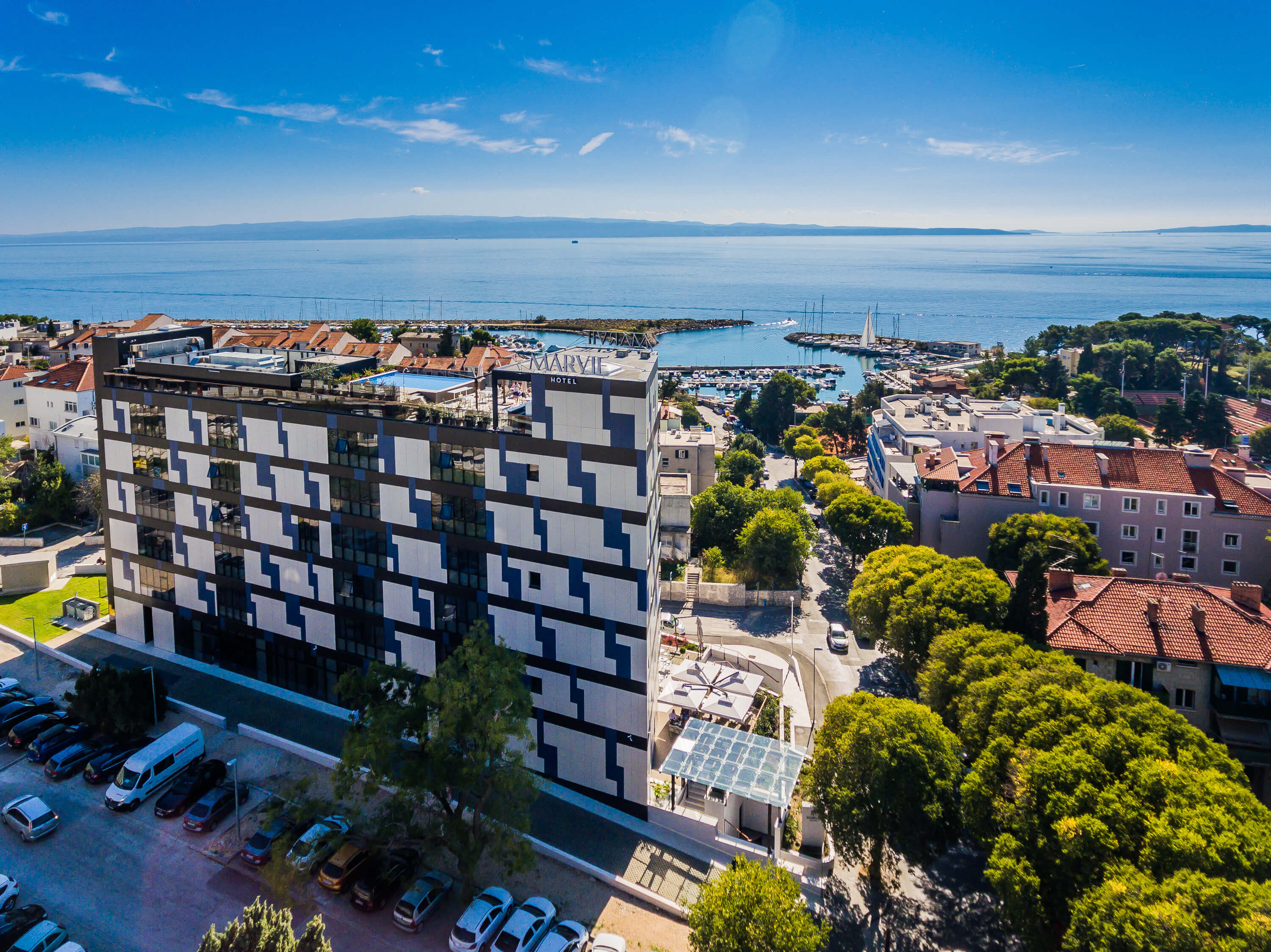
While embracing modern trends and following the belief that a global world that knows no boundaries can blend living, remote working, and traveling, Marvie has now launched an attractive, new offer, described by the name Marvie Living & Coworking and represented by the Long-term Stay Package.

Damira Kalajzic
An affordable long-term stay option, 28 days or longer, is now available at Marvie’s all year round, even during the summer season - and with a 50% discount. In addition, guests interested in long-term stays in Split, Croatia, now have the option of contacting Marvie Hotel & Health via a 15-minute free Zoom or Google Meets chat.

With the aim of creating a stimulating and productive living and working environment for hotel guests who are looking for long-term accommodation in Croatia, Marvie Hotel, within its Long-term Stay Package, offers Deluxe rooms with sea views, work desk, coworking space with 200 Mbps high-speed Internet, a projector and flipchart, as well as unlimited access to an indoor pool, jacuzzi, sauna, gym and relax zone.
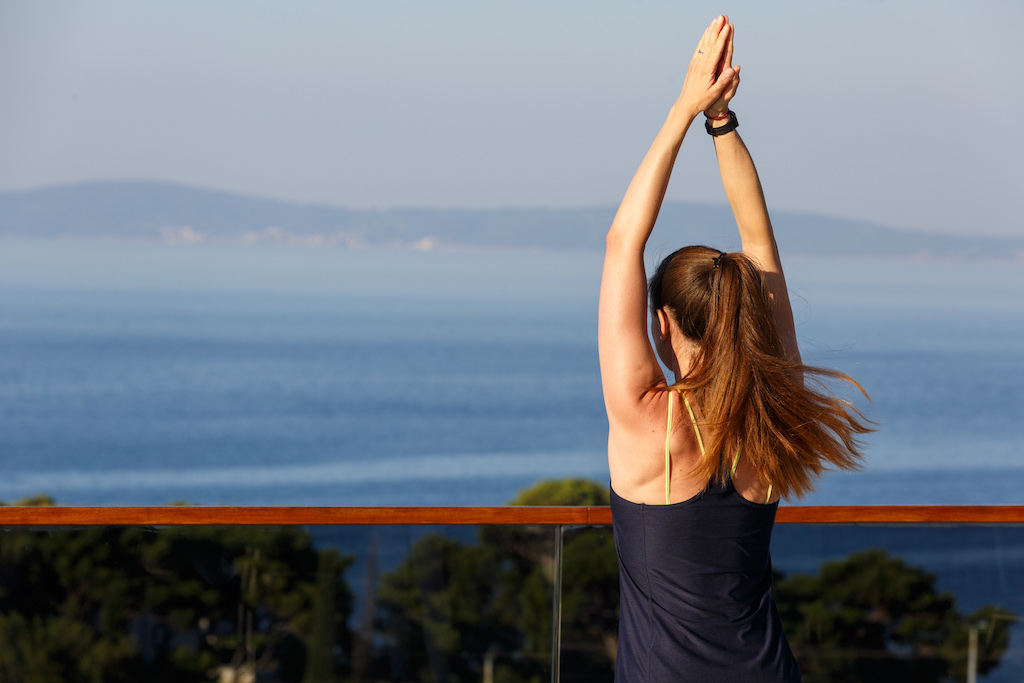
Marvie’s coworking space, which will be complete with ergonomic chairs and new desks in March, is open to both hotel guests and all other digital nomads in town. Other hotel spaces, which include Mareo Bar, Da’Mar restaurant, the lobby, as well as the rooftop poolside, can be used as alternative working spaces, where guests can work or exchange ideas and knowledge.
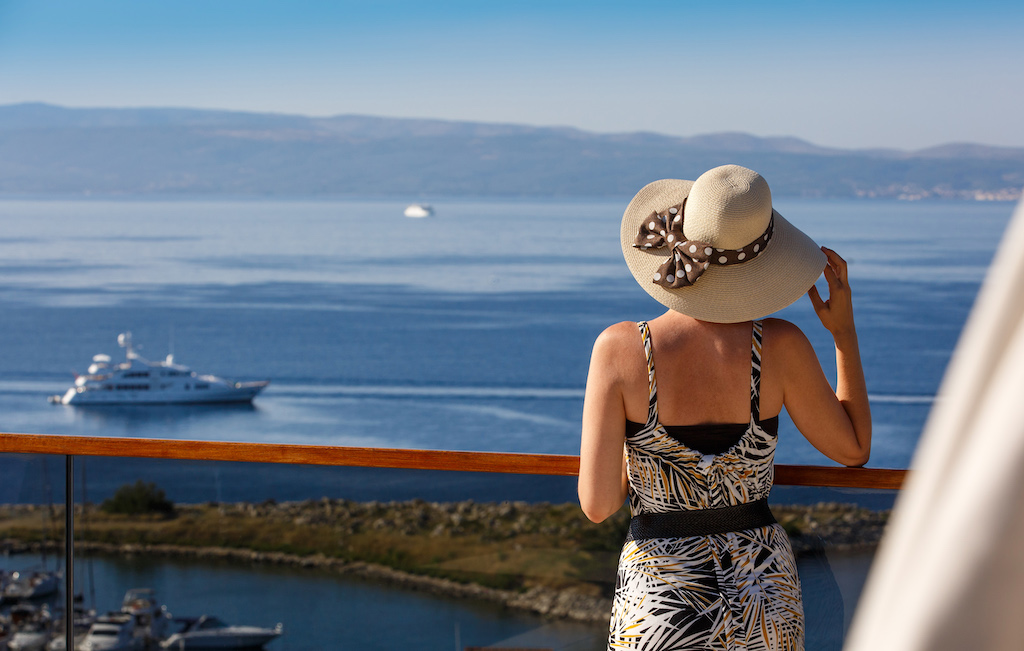
“Our mission is to actively participate and contribute to the design of a brand-new tourist product, which is changing the paradigm of traveling, remote working, and living. We are thrilled to witness more and more institutions begin to recognize the potential of this trend, as well as the founding of Digital Nomad Association Croatia, whose founders we are in contact with and who have helped us create a new product”, said Diana Rubić, general manager of Marvie Hotel & Health.

Damira Kalajzic
Marvie Hotel & Health is also popular for its health services such as dermatological treatments, non-invasive methods for facial and body rejuvenation, physical medicine and rehabilitation, dental services, and more. With the aim of providing opportunities for a longer stay and affordable prices, Marvie’s has also launched two carefully created 14-day health packages - The Physiotherapy and Nutrition Package. 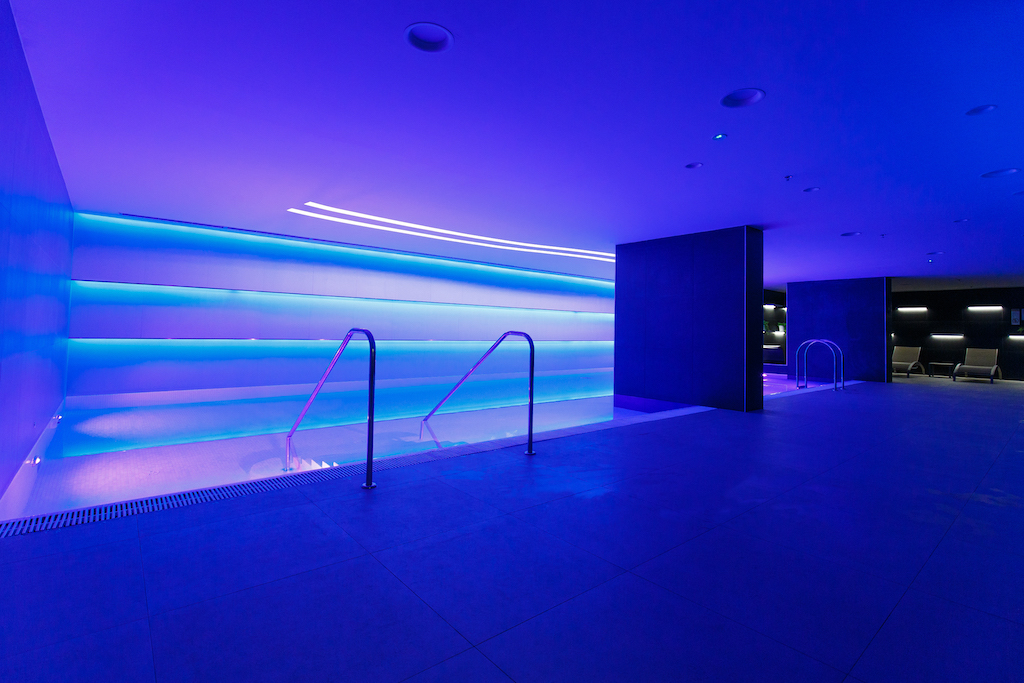
Digital nomads now have the opportunity to live in a sea-view 4-star hotel in Split at affordable prices and enjoy the many benefits that only Marvie Hotel & Health can offer in one place.
For more information on the prices and benefits of the Long-term Stay Package visit Marvie’s website, as well as a new blog section where you will be able to find topics related to digital nomads and Split with its surroundings - an ideal destination for working and living.
You can read more in English at the link: https://marviehotel.com/long-stay and follow Marvie's blog: https://marviehotel.com/blog
To read more about digital nomads in Croatia, follow TCN's dedicated page.
People Also Ask Google: How Many Days in Split is Enough?
February 23, 2021 - Continuing the TCN series answering the questions posed by Google's People Also Ask function, this time, one that is asked more often than not. How many days in Split is enough?
This is the ultimate question. And if you really wanted my honest opinion, I'd tell you to stay forever (here is why). Because that is not a reality for everyone, I've set out to find a happy medium for travelers making their way to Split, based on various scenarios, like seasons, main attractions, and those balancing the work-travel lifestyle of a digital nomad.
So, how many days in Split is enough?
While I have been visiting Split since 1996, I only really first fell in love with the city during my first full year here, or once I experienced Split outside of the peak summer months. September is now my favorite month in Split, and the magic of Diocletian's Palace during a brisk bura breeze or a warm spring day on Marjan is beyond compare.
But Split has and always will draw hordes of tourists in the summertime, and it's not difficult to see why. Thanks to its glistening coastline, outdoor activities, bustling city center, vibrant nightlife, and booming culinary scene, Split could equal one of Europe's top metropolitan cities if it maintained the summer buzz year-round.
But there is certainly an argument for each season and how many days are adequate given the time of year. Though I believe it all comes down to preference, in the end.
How many days in Split is enough in the preseason?
Ah, the magic of spring! While Croatia's preseason begins earlier each year, it's safe to say that Easter weekend is the official start of the preseason. However, before COVID-19, many airlines launched their summer flight schedules at the end of March, bringing tourists to Split even before the spring holiday. While there may not be as many connections now given the current circumstances (some airlines are pushing traffic back to May), if there is a will, there is a way - and Split in spring is pure bliss.
You'll notice restaurants and bars reopening after winter hibernation, sunny days and temps in the teens (Celsius), and empty alleyways usually swarmed by tourists in the summer. The biggest crowd you'll find is that of sunglass-clad locals gathering on the Riva for their morning coffee, enjoying every moment of spring sun before the summer storm (of tourists).
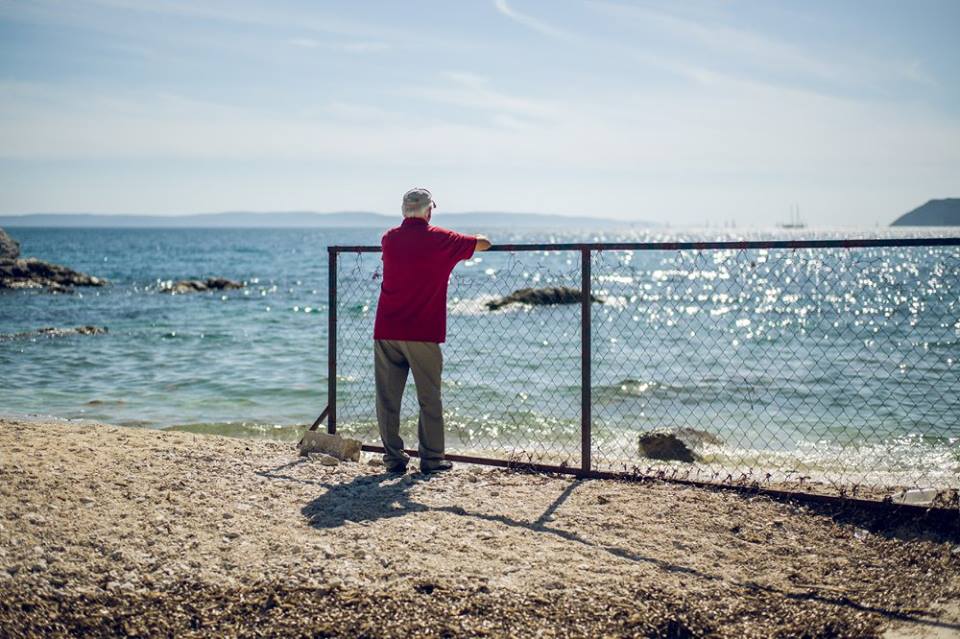
Matthew Christopher Miller
Nature flourishes in the spring. The local green markets are decorated with seasonal charms like wild asparagus and fava beans. Active tourism enthusiasts can hike in the hinterland or enjoy Mosor mountain without the blazing heat.
Spring is also crowned by events, the highlight of which is Split City Day, Sveti Duje, celebrated on May 7 each year. The event gathers thousands of citizens in the center for concerts, boat races, and fairs for days. While we can't say which events will happen this spring, the Croatia Boat Show has been announced for May, bringing the nautical elite, restauranteurs, and tourism reps to Split for five days before the official start of the 'peak' season.
Those of you looking to take day trips to islands will find that Jadrolinija still operates on the winter schedule, resulting in fewer connections (and much of the island closed). Still, those traveling by car can embark on journeys up and down to the coast, and even enjoy cheaper ticket prices at Krka National Park, only an hour away.
Visiting in the spring also comes with friendlier accommodation prices, making it a season with more bang for your buck!
Split in the spring is a sort of re-birth - when the city and its people come alive. While much of the city is just waking up, we suggest you take your time to enjoy the serenity of Split in the spring, and if you stay here long enough, you may even be able to swim.
How many days in Split is enough in the peak season?
Because most people choose to visit Split in the summer, how many days in the peak season is enough?
My honest answer to friends visiting from California is usually no less than five days. Why? Because while Split is a travel hub with access year-round, it is the epicenter of Dalmatia in the summer.
The truth is, those five days are never enough, and the majority of my friends plan to come for a week or more the next time they visit.
But what makes Split so hot (literally) in the summer?
In short, the city is a playground for all types of tourists. Whether you're in your early 20s and want to go bar hopping and nightclubbing until the early morning hours, or rather spend your days at the beach, trying your hand at water sports and rock climbing adventures, or exploring the historic center and its culinary charms, there really is something for everyone here.
And if you grow tired of Split (though highly unlikely)? It's the perfect base for a day trip to the islands, with numerous connections and Brač, Hvar, and Šolta only an hour away. You can hop on the bus or rent a car to visit the UNESCO-protected museum town of Trogir in 30 minutes, or head down the coast for a canyoning adventure in Omiš (but beware of summer traffic). You can tick off Šibenik, Primošten, and Rogoznica on a day trip to Krka National Park and head inland to horseback ride in Sinj (or watch the Sinjska Alka) in under an hour.
Music festivals like Ultra Europe see partygoers stay in Split for a week during the summer, while the Split Summer Festival and Diocletian Days events keep tourists amused with live music and historical entertainment for weeks on end.
The weather is HOT, the sun is shining, the sea is warm, and the air connections aplenty. If you don't mind the crowds or the heat, there is no time limit to Split in the summer. That is if you can afford it.
How many days in Split is enough in the offseason?
Split's shoulder season has become a favorite time for visitors, as September and October offer the perks of summer with usually milder weather and without the peakseason crowds.
The true offseason, however, is usually the quietest time of the year in Split. Some of Split's restaurants go into winter hibernation, as do its people, and empty squares and promenades are a reality in November.
But winter does have its perks, and while locals need some time to rest after a summer of hard work, they come back out to play in December for the festive Advent event. While we didn't get to enjoy it in 2020 due to obvious reasons, Advent usually lasts the entire month of December and into January, where you can ice skate, imbibe on mulled wine and hot gin, and enjoy sausages, live music, and Christmas-themed events.
You’ll also find that many restaurants in Split embrace the colder months with fare destined to warm your bellies, and many restaurants in the city stay true to the classics and traditions of Croatia for the new season to give you a taste of home cooking.
January and February are always the slowest months in Split, and whatever bars and restaurants reopened for Advent may close for 'renovations' until the spring.
But the offseason still offers plenty to do, like visiting its museums (Split City Museum, Meštrović Gallery, and Museum of Illusions are some of the most popular). You can enjoy ballet and musicals at the Croatian National Theater or catch the city's beloved football club Hajduk at Poljud until mid-December before they break until the end of January.
Split is also only a couple of hours away from Kupres in Bosnia & Herzegovina, a hit for Dalmatian skiers in the winter.
Nature never goes anywhere, and you could spend weeks exploring the natural wonders of the region with Split as your base. And if you can brave the winter bura wind, you may want to stay even longer.
How many days in Split is enough to explore Diocletian's Palace?
Now, one of the main draws to Split is Diocletian's Palace - and it's no surprise why. This UNESCO World Heritage Site was once Emporer Diocletian's retirement home, and today it wows world travelers thanks to its beauty and grandeur.
But how many days in Split do you need to explore this 4th-century palace?
It's first important to know that the palace makes up the city center's historic core and is marked by four gates through which you enter - the Golden Gate, Silver Gate, Iron Gate, and Brass Gate. Once you're within the palace walls, you'll notice shops, restaurants, bars, all connected by narrow cobblestone alleyways, which will likely get you lost more often than not.
The palace is also marked by many historical attractions, like the Saint Domnius Cathedral, Peristyle, Vestibule, Temple of Jupiter, and, of course, the famous substructures, or Diocletian's basement.
You could spend all day walking around Diocletian's Palace without really realizing it as local life bustles through, but should you stop to examine the details; you'll want to spend a bit of time here. Some say that a 75-minute walking tour is enough to experience Diocletian's Palace and its 1700-year-old history, which is probably true. But if you were to really embrace the essence of what Diocletian's Palace is for the city today, you'll need at least a few days eating and drinking your way around palace walls, among the locals, to stumble upon all of its charms.
How many days in Split is enough for a digital nomad?
If you're balancing the work-travel lifestyle and are planning on taking advantage of the new digital nomad visa in Croatia, we suggest you make full use and stay a year. Split is a mecca of coffee shops and new coworking spaces. You can enjoy fast internet, good weather, and safe streets. It's also affordable for long-term rentals in comparison to other European cities. Not to mention you'll get to experience everything I've written above - every season, every inch of Diocletian's Palace, and everything that makes Split as special as it is.
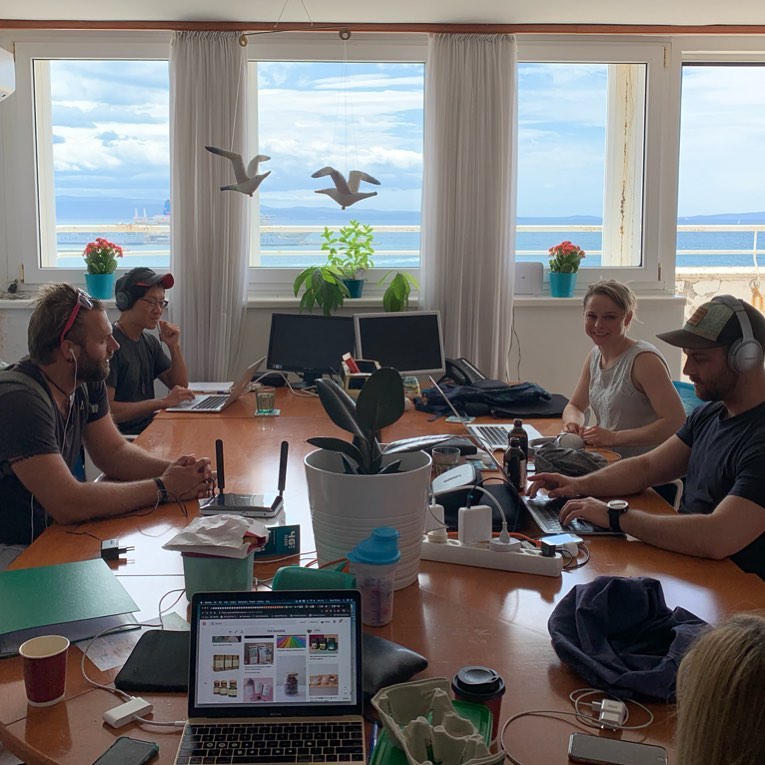
Saltwater Coworking Space
Conclusion: How many days in Split is enough?
All in all, that's entirely up to your time, budget and preference. Truly, there is no number of days too large. I am going on six years here and Split still finds ways to surprise me. You will certainly feel the magic of Split during an afternoon coffee or a night around town, but to truly embrace the essence of the city, do yourself a favor and stay a little longer.
To follow the People Also Ask Google about Croatia series, click here.
SkyUp Flights from Kyiv to Pula, Split, Dubrovnik Starting in June!
February 22, 2021 - The latest news for flights to Croatia: SkyUp flights from Kyiv to Pula, Split, Dubrovnik starting in June!
Croatian Aviation reports that the Ukrainian low-cost airline, which also operates charter transport, offers as many as three scheduled flights to Croatia in the 2021 summer flight schedule.
In 2019, this carrier operated only between Kyiv and Pula, while in 2020 there were no regular operations to Croatia due to the COVID-19 pandemic.
In the upcoming summer flight schedule, SkyUp will introduce two new routes to Croatia and resume traffic to Pula Airport.
The Kyiv - Split - Kyiv line will operate from June 19 to September 18, twice a week, every Wednesday and Saturday. On the route to Split and Pula, aircraft type B737-700, with a slightly smaller capacity (144 seats) was announced. On 27 return flights, SkyUp will offer more than 7,000 seats between Split and Kyiv.
The Kyiv - Pula - Kyiv line will operate from June 20 to September 19, twice a week, on Thursdays and Sundays. The airline will perform the same number of rotations on this line as to Split and offer a total of the same amount of seats from or to Pula Airport.
The Kyiv - Dubrovnik - Kyiv line will operate from June 25 to September 17, once a week, every Friday. B737-800 aircraft will operate on 13 return flights. In total, almost 5,000 seats are available on this line.
SkyUp is the second airline to announce a flight schedule to Croatia from Kyiv for the upcoming summer season, as Windrose has also confirmed its flight schedule to Croatia this summer.
Namely, Windrose will connect Kyiv directly to Pula, Split, Dubrovnik, and Zagreb.
Kyiv to Pula
The Kyiv - Pula - Kyiv line will operate from June 5 to September 25 this year. Three flights a week will be available on this route every Tuesday, Thursday, and Saturday from mid-June. On Tuesdays and Saturdays, A321 aircraft will operate between Kyiv and Pula, while on Thursdays, the two mentioned cities will be connected by smaller capacity aircraft - E145.
Kyiv - Split
On the same date, the line to Split will start operating, and as the line to Pula, it will operate three times a week, on the same days (Tuesdays, Thursdays, and Saturdays). A321 aircraft have been announced on Thursdays and Saturdays, while E145s will operate on Mondays.
Dubrovnik only once a week
In the summer of 2020, Windrose launched the Kyiv-Dubrovnik line, which will continue to operate this summer. The first flight is announced on June 18, once a week, every Friday. E145 aircraft will operate on the route.
No increase in Zagreb
The Kyiv - Zagreb line was introduced in the winter flight schedule 2020/2021. The company currently operates on this route twice a week, and although it had announced an increase in the number of weekly flights, it never came to fruition. The company has temporarily given up on that plan and will continue to operate between Zagreb and Kyiv twice a week, on Wednesdays and Sundays, this summer as well. On the route to Zagreb, Windrose will use E145 and ATR75 aircraft.
For the latest travel info, bookmark our main travel info article, which is updated daily.
Read the Croatian Travel Update in your language - now available in 24 languages.


